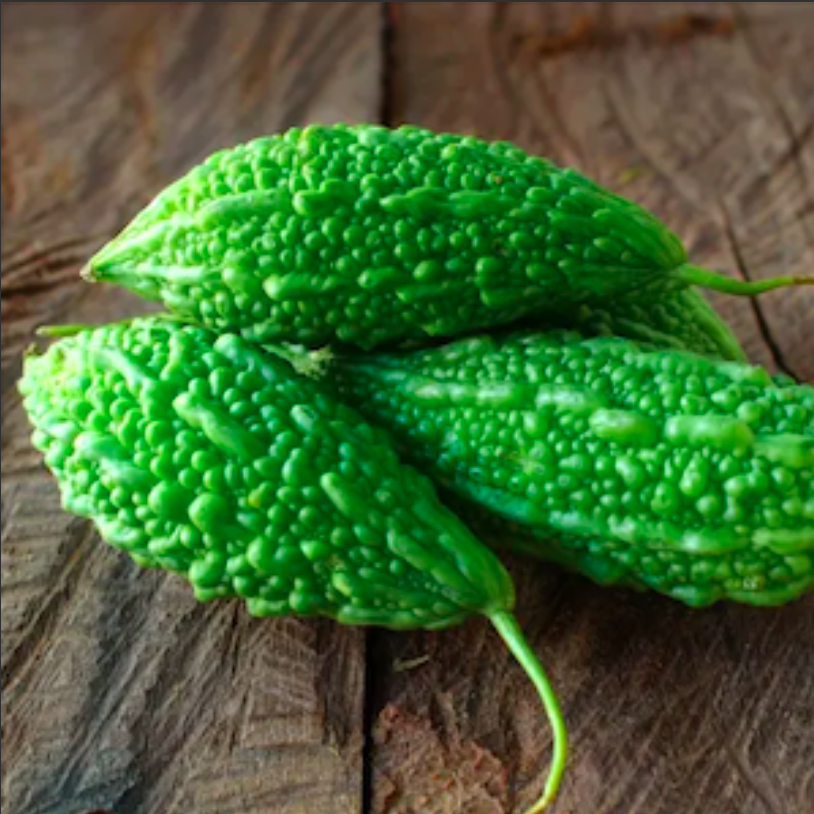 Bitter melon has an intriguing name, but its evolution from odd-looking edible fruit to a plant medicine perfectly suited for modern times is even more intriguing. A member of the cucurbit or gourd family, bitter melon (Momordica charantia) is native to Africa and Asia and is grown and used as a multifunctional vegetable in tropical, subtropical, and temperate climates, predominately in India and China. It is a vigorously growing vine with palmate leaves and clasping tendrils which support its numerous cone-shaped, knobby skinned fruits which turn from green to gold as the fruit ripens and bitterness peaks.
Bitter melon has an intriguing name, but its evolution from odd-looking edible fruit to a plant medicine perfectly suited for modern times is even more intriguing. A member of the cucurbit or gourd family, bitter melon (Momordica charantia) is native to Africa and Asia and is grown and used as a multifunctional vegetable in tropical, subtropical, and temperate climates, predominately in India and China. It is a vigorously growing vine with palmate leaves and clasping tendrils which support its numerous cone-shaped, knobby skinned fruits which turn from green to gold as the fruit ripens and bitterness peaks.
Bitter melon’s history of use as a food and medicine is rooted in East India, where it is known as kerala or bitter gourd. As a traditional medicine, bitter melon has been used to treat diabetes, high blood pressure, obesity as well as bacterial and viral infections. In fact, in parts of the world where access to western therapies, such as insulin injections and oral hypoglycemic medications are not affordable or available, bitter melon is vital to preventing and treating diabetes.
Research on bitter melon suggests that the whole fruit, its seeds and leaves all contain health-promoting nutrients as well as potent phytochemicals including phenolic compounds (flavonoids), alkaloids (momordicine), steroidal saponins (charantin), and insulin-mimicking polypeptides (known as p-insulin). These functional components support the body in many ways – enhancing antioxidant levels, which can decrease signs of aging, reducing blood sugar and cholesterol levels, and regulating intestinal flora. With metabolic syndrome on the rise throughout developed countries, bitter melon is gaining recognition as a pharmacological powerhouse which may reduce the incidence of chronic illnesses like diabetes and cardiovascular disease.
Polypeptide-p is a naturally occurring, insulin-like, hypoglycemic protein found in bitter melon seeds which when isolated and administered subcutaneously has been shown to lower blood glucose levels similar to the diabetes medication Metformin. Studies on bitter melon’s hypoglycemic effects indicate that its mechanism of action includes repairing damaged pancreatic β-cells, which increases insulin and insulin sensitivity. They also show that bitter melon can block the enzyme glucosidase, inhibiting the absorption of glucose. Other phytochemicals in bitter melon include flavonoids, saponins, tannins, triterpenes, and alkaloids. These can positively affect total cholesterol levels by increasing Apolipoprotein A1, which is associated with synthesis of HDL, the “good” cholesterol.
Additionally, bitter melon’s phenolic compounds are largely responsible for its formidable antioxidant power. By increasing catalase and levels of reduced glutathione, bitter melon appears to inhibit stress-induced lipid peroxidation, which is associated with aging, high cholesterol, and neurodegenerative diseases. Incredible! Not only does bitter melon enhance antioxidant status, emerging research indicates it may even suppress fat accumulation and release fat from adipose tissue which can promote healthy weight and further contribute to healthy aging.
When used as an herbal medicine, bitter melon is most often administered in one of four forms: fruit juice, freeze-dried powder, entire fruit, or capsule. If the idea of including a plant named bitter melon into your meal plan doesn’t whet your appetite, Peoples Rx has bitter melon available as single herb caplets and as part of a polyherbal formula called GlucoCare, both manufactured by Himalaya Herbs, a well-known GMP-certified supplier of high quality Ayurvedic herbs. One precaution, if you are currently taking diabetic medications, please consult your healthcare provider prior to use. If not, consider incorporating bitter melon into your metabolic wellness protocol today. You may be surprised by the results!
Author:
Jenny Perez is an Herbalist and Wellness Specialist at Peoples Rx. She received her Herbal Sciences degree from Bastyr University and has been an herbal educator and horticulturist for more than 15 years. Jenny has a passion for research and writing and helped develop the Food as Medicine article series for the American Botanical Council, contributing content for more than twenty articles. She teaches herbal pharmacy and compounding at the Wildflower School of Botanical Medicine and is the lead instructor for the Permaculture for Herbalists series.
References
Saeed F, Afzaal M, Niaz B, Arshad MU, Tufail T, et. al. Bitter melon (Momordica charantia): a natural healthy vegetable. International Journal of Food Properties, 2018, 21:1, 1270-1290.
Liu Z, Gong J, Huang W, Lu F, and Dong H. (2021) The Effect of Momordica charantia in the Treatment of Diabetes Mellitus: A Review. Evid Based Complement Alternat Med. 2021; 2021: 3796265.
Leung L, Birtwhistle R, Kitecha J, Hannah S, et.al. Anti-diabetic and hypoglycemic effects of Momordica charantia (bitter melon): a mini review. British Journal of Nutrition. 2009, 102, 1703-1708.
